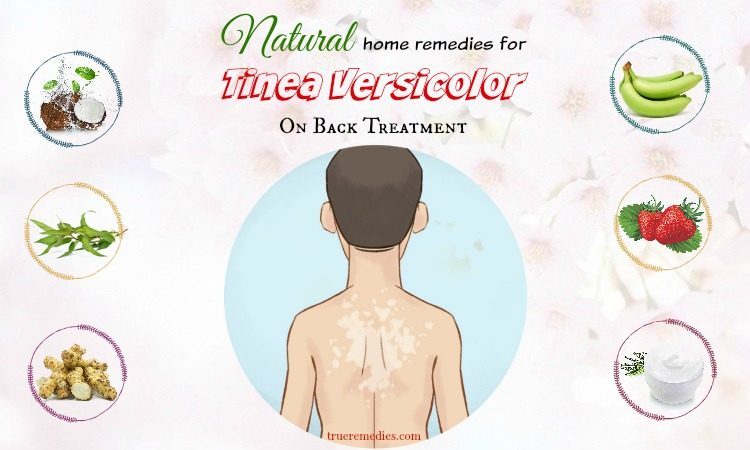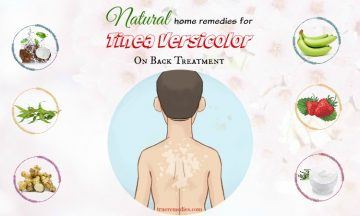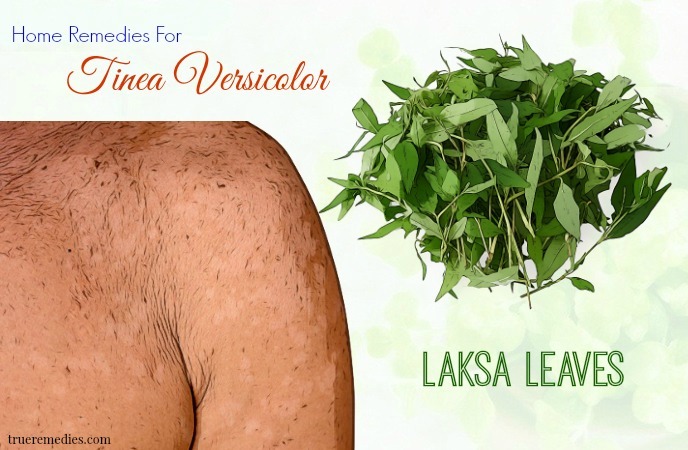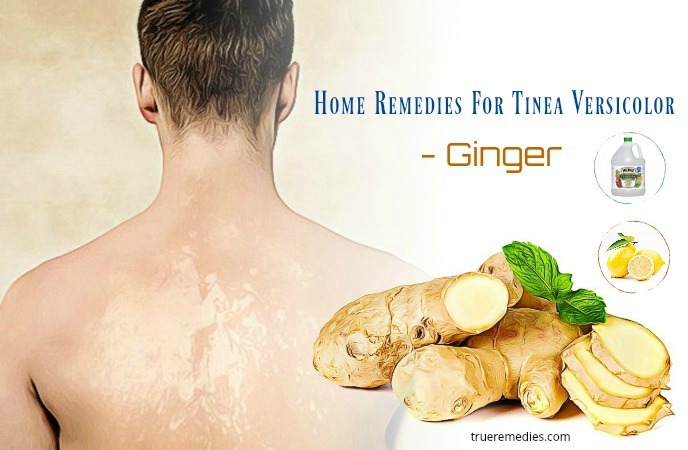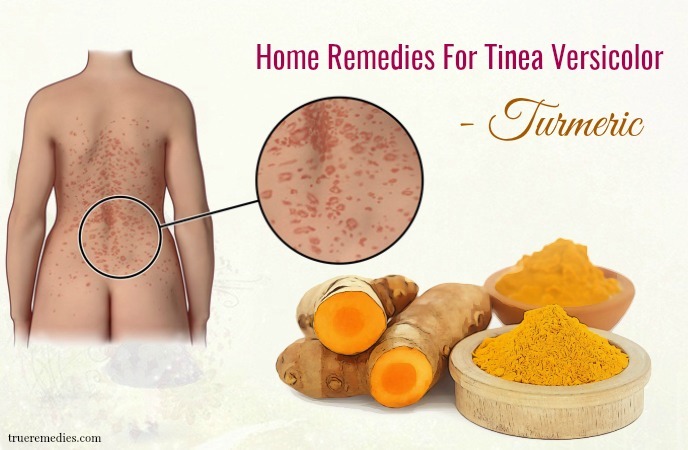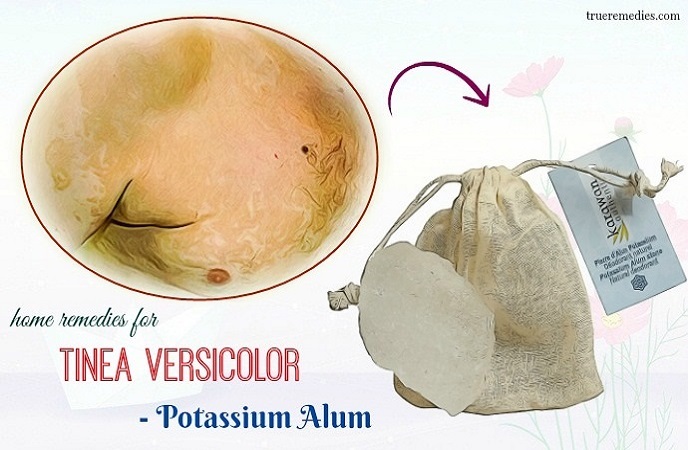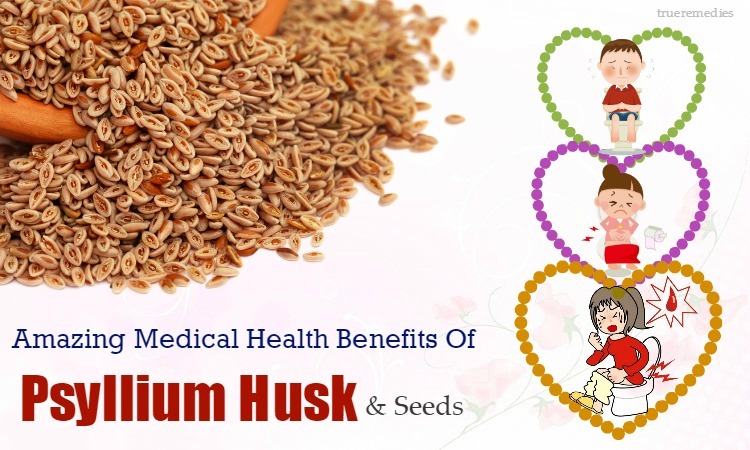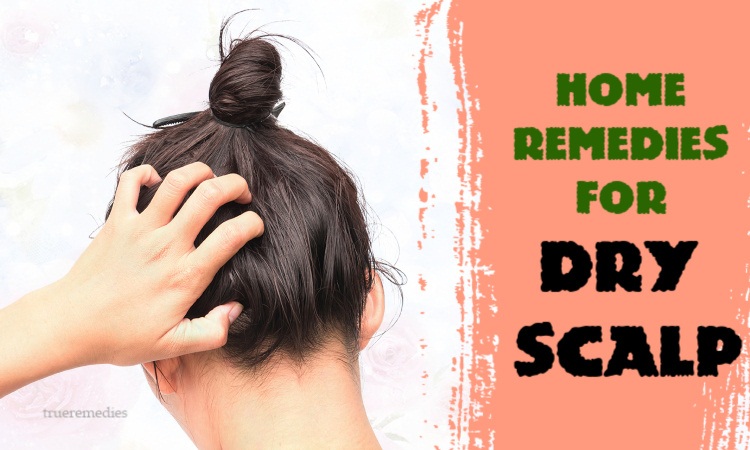Updated: 11/19/2019
Contents
Tinea versicolor is a fairly common disease. The disease is usually widespread in a tropical humid environment. It can also be easily spread from person to person by sharing clothing and towels. It is not dangerous but can make you less confident because of uneven skin color.
Understanding the cause and symptoms is one of the first things you need to prevent as well as treat this disease. This article will help you do that. In addition, very useful home remedies will be introduced to you to treat the disease quickly. Please do not ignore any of the information below as they are really important.
What Is Tinea Versicolor?
Tinea versicolor is a common skin infection. The disease occurs when the skin is infected with pityrosporum ovale. It usually does not affect your health. But in severe cases, the fungus develops leaving uneven skin color. Common symptoms of the disease are white or brown skin spots that appear on the face, back or chest. Many people think that dark or light skin spots are caused by peeling or sunburn. In fact, tinea versicolor is a skin disease caused by a mycobacterium called Pityrosporum ovale. This fungus prevents the absorption of ultraviolet light in the sunlight, so the fungal skin exposed to light will be white, while the fungal skin covered by clothing will be dark.
You probably do not know that this disease is usually widespread in a tropical humid environment. It can also be easily spread from person to person by sharing clothing and towels. It is not dangerous. Although not life-threatening, it makes you lack confidence when not wearing makeup or when wearing clothing revealing the skin on the back or chest. It is very easy to spread from certain skin areas to other skin areas of the body. In the early stages, tinea versicolor spots may appear in small skin areas, which can later spread to large areas such as the back, chest, and face.
Treatment of tinea versicolor is quite simple with antifungal medications, but it is likely to recur due to re-infection from objects or clothing which also carries pathogens. Therefore, treating the disease completely is absolutely necessary. That is good for you and your family members.
TrueRemedies Partner Solutions

Need a Help from the Leading Expert Online, Available 24/7?
They’re all here and ready to answer your questions online or by phone. Keep asking questions until you get the answer you need.
What Are Common Causes Of Tinea Versicolor?
Tinea versicolor occurs when the pityrosporum ovale grows on the skin. The disease can develop rapidly on the surface of the skin. Although doctors still do not find the specific reason for this excessive development, but they think that some following factors can make pathogenic fungus grow on the skin:
- Climate
Hot and humid climates are the main cause of tinea versicolor disease. This is a favorable environment for the formation and growth of pathogenic bacteria and fungi. To prevent pityrosporum ovale harm, you need to dry the body completely after bathing and shampooing. In addition, when washing face, do not use too much detergent because it can accidentally lose the natural protective layer of skin, making it more susceptible to fungal infections.
- Sweating
In people with active sweat glands, their skin is susceptible to dampness. This creates a favorable environment for pathogenic fungi to develop. Skin areas which are often sweaty are back, chest, abdomen, face, armpits and thighs. As a result, signs of the disease often appear early on these skin areas.
Read more: 24 Home Remedies For Excessive Sweating On Face, In Palms & Feet
- Skin Cleansing
Excessive cleansing is not good, but if you do not clean your skin, leaving your skin dirty, the risk of skin infections is very high.
- Oily Skin
Oily skin is also one of the causes of this condition. Oily skin makes the skin always moist. This causes the pathogenic fungus to have many opportunities to form, grow and spread.
- Weakened Immune System
The weakened immune system makes the body unable to prevent the attack of pathogenic fungi.
- Endocrine Change
Hormonal changes due to puberty, pregnancy, or certain diseases can also be responsible for the disease. After the middle age, the possibility of disease decreases because the body gradually decreases the excretion of oil and sweat.
- Other Causes
Often wearing wet clothes, suffering from other skin conditions, long-term use of corticosteroid medications and high levels of cortisone in the body may also be responsible for this condition.
Fungus that causes tinea versicolor can still be found on healthy skin. It only starts to cause problems when the fungal pathogen develops excessively.
What Are Common Symptoms Of Tinea Versicolor?
Here are the common symptoms of this disease:
- The strange spots appear on the skin and their size gradually increases with time.
- These spot is lighter or darker than the surrounding skin areas’ color. The spots are maybe white, pink, red, or brown.
- The spots may appear anywhere on the body, but often appear on the neck, chest, back and arms.
- Spots may be dry, scaly and cause itching.
- Unlike healthy skin, the affected skin areas do not make contact with sunlight.
- As pathogenic fungi grow, the spots may combine and form lighter (or darker) areas of skin.
- The spots may disappear when the temperature decreases. However, it will return in the spring or summer when the air becomes warm and humid.
You may experience other symptoms not mentioned. If you have any questions about the signs of the disease, please consult your doctor.
Who Is At High Risk Of This Disease?
Tinea versicolor is very common and can occur at any age or race, but it usually occurs in teens and adults. As we mentioned, the higher the age, the less chance of disease. Tinea versicolor is one of the most common skin diseases in the tropics and subtropics of the world. In addition, people who work outdoors and sports athletes are also at high risk of this disease. You can control the disease by reducing your risk factors. Please talk to your doctor for more information.
When To See A Doctor?
You should contact your doctor if you have any of these signs:
- Skin condition is not improved after a period of treatment at home.
- Recurrent fungal infection.
- Skin lesions spread in many areas of the body quickly you cannot control this.
Besides, if you have any of these signs or symptoms or have any questions, please consult your doctor. The condition of each person is different, so let’s consult your doctor to select the most suitable option.
So you have just learned about the most basic information about tinea versicolor. Surely you must have the most comprehensive view of this disease. Although this disease is not life-threatening, it negatively affects your confidence. Therefore, it should be treated as soon as possible. Below, we will introduce you to effective home remedies for tinea versicolor on back treatment. They have been proven to be safe and effective by many people. You will be surprised at the results that they bring you. Take a look at TrueRemedies.com!
Top 35 Natural Home Remedies For Tinea Versicolor On Back Treatment
1. Laksa Leaves
This is the first home remedy in this list of home remedies for tinea versicolor treatment. Laksa leaf is first known as a spice used in our daily meals. In addition, this vegetable is used as a cure for many diseases.
According to oriental medicine, laksa leaf is spicy. It has a characteristic aroma. In addition to the treatment of urinary, snakebite and hemorrhoids, laksa leaves used to treat tinea versicolor because they have high antiseptic properties. This vegetable also helps to treat the itchiness caused by tinea versicolor, thereby helping to prevent the spread of the disease.
To use laksa leaves to treat tinea versicolor, you can apply one of these following methods:
Method 1. Just Laksa Leaves
To apply this method, please follow these steps below:
- Prepare a handful of laksa leaves
- Pound them
- Apply them to the affected area
- After 10-15 minutes, rinse affected skin with water and dry it with a clean towel
Please apply this method 2-3 times a day, each time for 15-20 minutes for the best results. Note that you should only stop treatment when the disease is completely treated.
Method 2: Laksa Leaves And Wine
To apply this method, please follow these steps below:
- Prepare a handful of laksa leaves and a little wine
- Pound laksa leaves, then add white wine and stir well
- Use this mixture to apply to the affected area
- After 10-15 minutes, rinse affected skin with water and dry it with a clean towel
It’s so simple and you can do it right at home. Please apply this method 3-4 times a day until your condition is fully treated. Surely you will be surprised about the results that this method brings.
2. Coconut Oil
This is another must-try home treatment in this list of home remedies for tinea versicolor treatment. Coconut oil is a proven method to treat tinea versicolor. Although the application of coconut oil to the affected areas is not included in the treatment plan for tinea versicolor, the results of this remedy are surprising. Many people have succeeded in treating this disease in this way [1].
Coconut oil is considered as a natural antibiotic. This natural oil contains an anti-bacterial and anti-fungal- Lauric acid component. Average chain fatty acids account for nearly 50% of the fatty acids in coconut oil. The average chain fatty acid in coconut oil is similar to that in breast milk. They all have very good antimicrobial properties.
When consumed as a food, coconut oil is converted into a monoglyceride called monolaurin. When used internally, it is capable of killing harmful bacteria, fungi and viruses. Therefore, coconut oil is very effective in treating tinea versicolor.
To apply this remedy, please follow these steps below:
- Prepare a sufficient amount of coconut oil (depending on the width of the affected skin area).
- Clean the affected skin are, then apply coconut oil into these skin areas
- Massage gently for about 2-3 minutes
- After 5-10 minutes, rinse affected skin with water and dry it with a clean towel
Apply this remedy twice a day for at least a week to get the best results.
3. Galangal
This remedy is one of little – known home remedies for tinea versicolor treatment. Galangal is not only used as a condiment, but also used as a cure for many diseases. Galangal contains active ingredients with anti-inflammatory properties, so it is very beneficial in the treatment of arthritis and rheumatism.
In addition, galangal contains antioxidants which help reduce the damage caused by free radicals and other toxins in the body. Therefore, it helps prevent and treat skin diseases such as tinea versicolor, scabies, ulcers, and inflammation. This is a very simple way to cure tinea versicolor.
To use galangal to treat tinea versicolor, you can apply one of these following methods:
Method 1. Just Galangal
To apply this method, please follow these steps below:
- Prepare a fresh galangal
- Wash and crush it
- Clean the area of the affected skin, then apply the crushed galangal on the these skin areas
- After 10-15 minutes, rinse affected skin with water and dry it with a clean towel
Apply this remedy twice a day for at least a week to get the best results. In addition, you can add a few drops of lemon juice to increase the effectiveness of this method.
Method 2. Galangal And Wine
To apply this method, please follow these steps below:
- Prepare a fresh galangal and a little wine
- Crush galangal, then add white wine and stir well. Wait until the mixture changes color, you can use it
- Use this mixture to apply to the affected area
- After 10-15 minutes, rinse affected skin with water and dry it with a clean towel
Please apply this method 2-3 times a day to get the expected results.
4. Ginger
The next treatment in this list of home remedies for tinea versicolor is using ginger. Ginger is not a strange spice in the family meal. We can use ginger as a spice for delicious and attractive dishes.
Additionally, ginger is a popular drug used from the past. Modern scientific research shows that ginger has a complex chemical composition. It contains zingiberene, phellandrene, ketone, ginger, citral, perfume, capsaicin, and diphenyl-heptane. Scientific research has found that ginger plays a role similar to natural antibiotics.
In traditional medicine studies, ginger has analgesic effects. Ginger also prevents the growth of fungi and bacteria very effectively. Therefore, ginger can be used to treat diseases such as rheumatism, tinea versicolor, diarrhea and some other kin diseases.
During hot summer days, pityrosporum ovale has favorable conditions for development, causing tinea versicolor disease. The use of ginger during this time helps prevent or treat this condition. Besides, ginger also boosts your immune system. A healthy immune system can help you be completely safe in this situation.
To use ginger to treat tinea versicolor, you can apply one of these following methods:
Method 1. Just Ginger
To apply this method, follow these guidelines:
- Prepare a fresh ginger
- Wash and crush it
- Clean the area of the affected skin, then apply the crushed ginger on these skin areas
- After 10-15 minutes, rinse affected skin areas with water and dry it with a clean towel
Apply this remedy twice a day for at least a week to get the best results.
Method 2. Ginger And Lemon
To apply this method, take these steps below:
- Prepare a fresh ginger and a few drops of lemon juice
- Wash and crush ginger, add lemon juice, then heat them up
- Let this solution cool down, clean the area of the affected skin and then use a cotton swab to apply this solution into these areas
- After 10-15 minutes, rinse affected skin areas with water and dry it with a clean towel
Apply this remedy twice a day for at least a week to get the best results.
Method 3. Ginger And Vinegar
To apply this method, follow these steps below:
- Prepare a fresh ginger and 100ml of vinegar
- Wash and crush ginger, then add vinegar and stir well
- After about 8 hours you can use ginger that has been soaked with vinegar to apply to the affected area
- After 10-15 minutes, rinse affected skin areas with water and dry it with a clean towel
Before applying this method, do not forget to wash and dry your affected skin areas. This is important because if you let them get wet, the pathogenic fungus will have more opportunities to grow. Apply this method once a day. After about 5 days, you will see a noticeable improvement.
5. Aloe Vera
Aloe vera is the oldest medicinal plant renowned for its healing effects. The gel of aloe vera leaves can help soothe cuts, acne, burn, itching and burning. It is thanks to a wide range of vitamins and minerals such as vitamin A, B12, B group vitamins, C and E, folic acid, amino acids essential for the human body.
Also, the sap of aloe vera leaf possesses antimicrobial and antiseptic properties that can help fight off inflammation and pain. This plant contains 6 antiseptic substances, which are salicylic acid, sulphur, lupeol, nitrogen and urea. They help in killing off bacteria and funguses. That is why aloe vera is worth mentioning in this list of home remedies for tinea versicolor.
What you need to do is:
- Cut 2 clean aloe vera leaves into halves to extract its gel
- Place it over your affected area
- Let it dry on its own
- Repeat this routine 3-4 times per day for 2-3 weeks to get good results
6. Baking Soda
As far as home remedies for tinea versicolor can go, baking soda is really a good solution. Baking soda is the cheapest and healthiest product that helps us in various purposes, from serving as a mouthwash, breath freshener to teeth whitener. It is also a great remedy for different diseases, including yeast infections. Actually, tinea versicolor is one of yeast infections that baking soda can handle. It is a persistent disease provoked by the overgrowth of skin fungus. Using baking soda can destroy the fungus which develops in acidic environment thanks to its anti-acidic properties [2].
There are some ways you can use baking soda for tinea versicolor relief. Some of the best are:
Method 1: Baking Soda And Honey
This method will give your important antioxidants as well as antifungal elements that can alleviate your skin condition.
- Mix baking soda and honey as the ratio of 1:1
- Add extra virgin olive oil (optional) for additional benefits
- Put it over your affected area and leave it there for 15 minutes
- Wash it off using tepid water
- Repeat this routine 3 times per week
Method 2: Baking Soda Bath
- Pour ½ – 1 cup of baking soda to your bath water
- Add Epsom salt and apple cider vinegar for better effectiveness
- Soak yourself in the water for 20 minutes or so
- Repeat this routine daily to get radiant skin
Alternatively, you can also mix baking soda with tea tree oil to get similar effects.
Method 3: Baking Soda And Hydrogen Peroxide
This combination serves as a good face bleach and acne remover that can cleanse your skin. However, remember that you should not use hydrogen peroxide for a long time as it will dry out your skin and may result in irritation.
- Use 2 tablespoons of baking soda mixed with hydrogen peroxide to create a good paste.
- Apply the paste over your affected skin and rinse it off after 15 minutes
- Apply your moisturizer as normal
7. Strawberries
Strawberries look fantastic both on your salad dish and your face. Due to its anti-inflammatory and various vitamins and minerals, this fruit help to reduce yeasts. Just a ripe strawberry combined with a tablespoon of baking soda and rubbed over your affected areas is enough to decrease the yeast.
8. Yogurt
The benefits of yogurt for health are vast because it is loaded with good bacteria which are helpful for regulating metabolism and digestion. Yogurt should be a part of your diet because it supports to maintain the good balance between the fungi and the healthy bacteria within your body, thereby preventing excessive growth of fungi while still preventing infections.
Apply plain, unsweetened yogurt over your affected area and wait for 30 minutes to wash it off with mild soap. Also, consume yogurt daily to help kill off the yeast within your body.
9. Neem
Neem is known for its multiple benefits, especially for the skin. Having antimicrobial properties, this ancient herb becomes an efficient remedy for tinea versicolor.
Just simply boil neem leaves in water till they become infused. After straining water, use it to shower your body instead of plain water. Besides, you should also apply neem leaf paste on your affected areas. Leave it there for 15 minutes before washing it off with tepid water.
If neem oil is available, use it to apply onto your problematic area after showering.
10. Tea Tree Oil
Tea tree oil is the oil taken from the leaves of Melaleuca alternifolia tree. This plant is native to Southeast Queensland plus with Northeast coast New South Wales, Australia. This oil is traditionally used to treat a number of conditions, such as abrasions, insect bites, burns, stings, vaginal infections, recurrent herpes, boils, toothaches, mouth infections, labialis, etc. One of the best natural home remedies for tinea versicolor is tea tree oil, which has antifungal properties. This essential oil can relieve itchiness associated with tinea versicolor. It also inhibits the spread of infections and prevents future recurrence. However, remember to dilute it with carrier oil prior to applying directly onto your skin to avoid any possible burning sensation.
11. Lavender Essential Oil
This essential oil is lethal to fungal infections. Lavender oil has an ability of killing fungus and bacteria causing tinea versicolor. A study carried out in 2005 showed that lavender essential oil can eliminate 100% of Candida albicans within just 15 minutes. This oil is also highly soothing and provides a relief from burning or itching associated with fungal infections. However, more studies should be done to confirm these results.
12. Clove Essential Oil
Clove oil is famous for the ability of fighting candida, athlete’s foot, and ringworm thanks to its anti-fungal property. Thus, it is one of most effective home remedies for tinea versicolor. It also helps stop the bacteria invading an open wound to trigger an infection.
13. Peppermint Essential Oil
Having anti-inflammatory, anti-septic and anti-viral properties that might help stop the condition of tinea versicolor. You can make a mixture between patchouli, tea tree, lavender, clove and peppermint oil to treat tinea versicolor.
What you have to do is:
- Mix 10 drops each of patchouli essential oil, tea tree oil, lavender oil, clove oil with 5-8 drops of peppermint oil (optional)
- Then, put 30 drops of carrier oil like coconut oil or almond oil
- Pour the mixture into a 10ml roller bottle and shake well
- Roll the bottle onto your affected areas 3 times per day
- Repeat this routine up to 1 week to get good results
Note: Do not let this mixture contact your eyes.
14. Candle Bush
Candle bush is a little-known option among home remedies for tinea versicolor on back. Also known as senna alata, candle bush is a powerful herb that can treat various skin infections, such as ringworm and tinea versicolor [3].
You can grind fresh candle bush leaves, then mix it with olive oil before applying to your affected area. Do this method twice per day to get the best results. Alternatively, you can also purchase a preparation made of candle bush instead of fresh one to do this method.
15. Turmeric
Turmeric is another suggestion when it comes to home remedies for tinea versicolor. It can help restore the natural skin color. The anti-microbial property of this spice can prevent skin infections while anti-septic and anti-inflammatory properties can treat tinea versicolor symptoms efficiently [4].
- Take some turmeric powder to mix with water to create a good paste
- Apply the paste over your affected area
- Leave it there for 30 minutes before removing with tepid water
- Repeat this routine daily to remove discolored skin patches
16. Eucalyptus Oil
Unlike other home remedies for tinea versicolor, eucalyptus oil should be used in a different manner. Mix this oil with a tint of coconut oil or tea tree oil, then apply over your skin. This will help unveil your new skin cells in just a few days [5].
17. Oregano Oil
Oregano oil is reckoned one of the most underrated sources of powerful antifungal oils used wordwide. It can fight off the fungi responsible for tinea versicolor and combat rash.
What you need to do is:
- Mix equal parts of olive oil and oregano oil together
- Apply the mixture over your skin using a cotton ball
- Wait for 30 minutes before rinsing it off with tepid water
- Follow this treatment once per day for several weeks
18. Patchouli Essential Oil
With its rich, earthly scent, patchouli essential oil is rather popular in the hippie culture. This essential oil is used to deal with many skin issues, including dandruff, stretch marks and acne. Patchouli essential oil acts as a powerful antifungal oil which can help kill bacteria and fungus causing tinea versicolor.
You can create your own lotion by mixing this oil with coconut oil. Then, apply the mixture over your skin daily after having a bath. Use this method daily to prevent future recurrence.
19. Listerine
You may be surprised at this tip, but this mouthwash does work. Just simply take a cotton ball to dip into Listerine and apply it over your affected areas [6]. You will soon notice your infection disappearing slowly after using this remedy for about one week.
20. Green Banana
This sounds strange when it comes to home remedies for tinea versicolor on back, but it is very effective. Banana is a daily food that is rich in nutrients, vitamins, and minerals for the body. According to new research, we have found that bananas contain many nutrients such as protein, lipid, iron, potassium, and vitamins A, B, E. This is really a fruit that you should eat every day. It boosts your digestive system, helping you fight all kinds of illnesses. Besides, green banana is used to treat some skin diseases, including tinea versicolor.
Green banana contains many active ingredients that inhibit inflammation. The pus of green banana is high in antimicrobial and antifungal properties, so it can effectively kill the pathogens. Banana also contains many nutrients to help heal wounds and regenerate new skin quickly. This is really what the patients with tinea versicolor need.
To apply this remedy, please follow these steps below:
- Prepare a green banana
- Cut it into thin slices
- Clean the area of the affected skin, then rub gently these banana slices on these skin areas
- After 10-15 minutes, rinse affected skin areas with water and dry it with a clean towel
Apply this remedy 2-3 times a day. After a week of persistent application, you will notice that the affected areas are gradually improved. These areas will be completely restored after about 2 weeks using green banana.
21. Garlic
Using garlic is also one of the little-known home remedies for tinea versicolor treatment. Garlic is quite familiar in everyday life because it is an indispensable spice in the food. In addition, garlic is a natural medicine with strong medicinal properties. Garlic is also considered a natural antibiotic. Its ability to enhance the body's resistance is a highlight. This information is very important for patients with tinea versicolor, because poor resistance is one of the major causes of this disease [7].
The composition of the garlic is mainly Alicine – a powerful antibiotic with antibacterial, antiviral, and anti-fungal properties. Some new research also suggests that garlic can prevent cancer and some other diseases. Tinea versicolor is a skin disease caused by a mushroom and you can use garlic to treat this disease in a short time.
To apply this remedy, please follow these steps below:
- Prepare a few cloves of fresh garlic
- Wash and crush them
- Clean the area of the affected skin, then apply the crushed garlic on these skin areas for about 30 minutes
- Rinse affected skin areas with water and dry it with a clean towel
You should do this treatment in the evening. Do not leave the garlic too long on the skin because garlic can irritate the skin (the medicinal properties of garlic are strong). Performing this remedy every night for about 1 week to 10 days, your problem will be improved.
22. Potassium Alum
The next one in this of the effective home remedies for tinea versicolor on back is using potassium alum. Potassium alum is the double sulfate salt of potassium and aluminum. Its chemical formula is KAl (SO4) 2 and is usually found in hydrated form as KAl (SO4) 2·12H2O. According to traditional medicine, potassium alum is an antiseptic. Therefore, it is used as a method to treat tinea versicolor. It also removes the itchiness that this disease causes. This is really a remedy that you should try at least once. In addition to potassium alum, the oriental doctors advise to use more sulfur powder to increase the effects of this remedy.
To apply this remedy, please follow these steps below:
- Preparation of alum and sulfur powder in a ratio of 1: 1, and a little vinegar
- Mix alum and sulfur powder, then add vinegar to form a thick mixture
- Clean the areas of the affected skin and dry them with a clean towel
- Apply the mixture above into these skin areas and let it dry without rinsing
Please apply this remedy twice a day to get the best effects. It will not disappoint you.
23. Shell Of Grapefruit
No wonder, this is definitely one that should be mentioned in this list of home remedies for tinea versicolor. Using oil of grapefruit’s shell is one of the effective ways to treat tinea versicolor. This natural oil has good anti-inflammatory and antibacterial properties.
You just need to fold shell of fresh grapefruit lightly so that the oil from the shell spray into the affected skin areas. You may feel a little pain when the oil comes into contact with the skin, but the pleasant feeling will gradually appear. Then, let it dry without rinsing. Please keep applying this remedy 1-2 times a day until the disease is completely healed. Using shell of grapefruit is considered one of the best natural home remedies fortinea versicolor.
24. Onion
Using onion is the next remedy in this list of home remedies for tinea versicolor treatment. We all know that onion is rich in vitamins A, B, C. It is a potential source of folic acid, calcium, phosphorus, magnesium, chromium, iron, and fiber.
Onion is considered to have high anti-inflammatory properties. Specially, it contains allicin – a sulfur compound that makes up the pungent odor, along with other cysteine and antioxidants that help fight inflammation as well as help boost immunity and prevent some diseases. Sulfur in the onion prevents the formation of blood clots, restricts bad cholesterol in the blood, and reduces triglycerides.
Onions plays a role of a strong antibiotic, which acts against respiratory tract infections, helping heal wounds and burns quickly. Therefore, onion is really useful in the treatment of tinea versicolor.
To use onion to treat tinea versicolor, you can apply one of these following methods:
Method 1: Home Remedies For Tinea Versicolor Using Only Onion
To apply this method, please follow these steps below:
- Prepare 20 grams of fresh onion
- Wash the onion then crush it
- Clean the areas of the affected skin
- Use the onion above to apply to your tinea versicolor area
- After 10-15 minutes, rinse affected skin areas with water and dry it with a clean towel
You can implement this method before going to bed for the best treatment.
Method 2: Onion And Salts
To apply this method, please follow these steps below:
- Prepare 20 grams of onion and 2 teaspoons of salt
- Wash the onion and crush it
- Add the onion and salt into a bowl then steam them for 10 minutes
- Leave for 5 minutes to reduce the heat of the mixture then use the mixture to apply to your tinea versicolor area
- After 10-15 minutes, rinse affected skin areas with water and dry it with a clean towel
You can implement this method twice a day for the best result. Be notice to rinse off your skin before apply the mixture to your tinea versicolor area.
Method 3: Onion And Honey
To apply this method, please follow these steps below:
- Prepare a half of onion and ½ teaspoon of honey
- Wash the onion, then cut it into small pieces
- Squeeze the onion above to extract the juice
- Add honey to the juice of onion then stir well
- Clean the areas of the affected skin
- Use a soft cotton swab to apply this mixture into the tinea versicolor area
You can implement this method once a day in the evening. The best effect of this method will be showed when you apply it before going to bed. Leave the mixture in your skin overnight. Then rinse your skin by cool water in the next morning.
Note: The mixture of onion and honey is not safe with your eyes, so please be careful when your tinea versicolor area is near your eyes.
25. Apple Cider Vinegar
This is the last remedy in this list of home remedies for tinea versicolor treatment. Apple cider vinegar is a type of vinegar made from apple alcohol or apple. The apple cider vinegar contains a lot of acetic acids, proteins, enzymes, antioxidants, amino acids, K, P, Ca, Mg, Cu, vitamins A, B1, B2, B6, C, and E, bioflavonoid, pectin and many micros bacteria which are very necessary for the body. Apple cider vinegar contains a compound called malic acid – it is a powerful antimicrobial, anti-fungal and anti-viral compound. Therefore, the using of apple cider vinegar in treating tinea versicolor is a good choice.
To use apple cider vinegar to treat tinea versicolor, you can apply one of these following methods:
Method 1: Only Apple Cider Vinegar
To apply this method, please follow these steps below:
- Prepare 2 teaspoons of apple cider vinegar
- Rinse your skin with tinea versicolor by warm water then use apple cider vinegar to apply to these skin areas
- Leave for 15 minutes then rinse your skin with cool water
Don’t forget to dry these skin areas with a clean towel. You can implement this method 3-4 times a day for the best results.
Method 2: Apple Cider Vinegar When You Take A Shower
To apply this method, please follow these steps below:
- Prepare 200 ml of apple cider vinegar
- Pour the apple cider vinegar into your bathtub
- Stir well then soak your body into bathtub for 30 minutes
You can implement this method every day for 1-2 weeks.
Here are the home remedies for tinea versicolor that we would like to introduce in this article. Hope that they will help you treat the disease as quickly as possible so you can regain your confidence. Do not worry about their safety as this has been proven by many people. If you have any contributing ideas about our article of “Top 35 Effective Home Remedies For Tinea Versicolor Treatment” introduced in Home Remedies Category, do not hesitate to drop your words below this post. We will answer as soon as we could.

